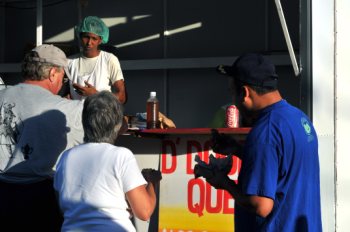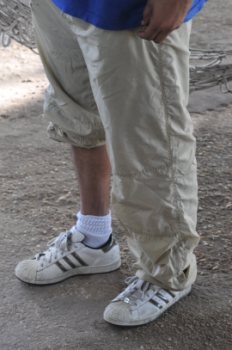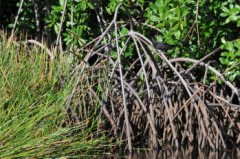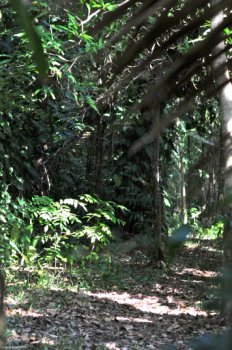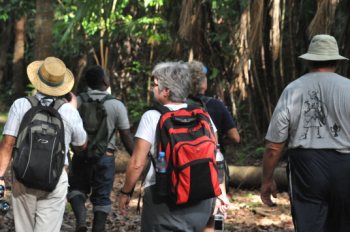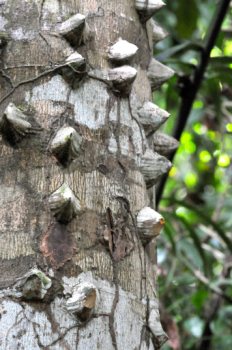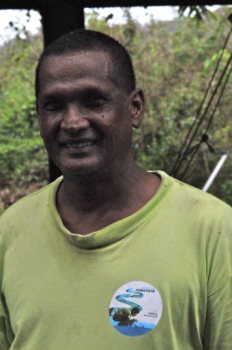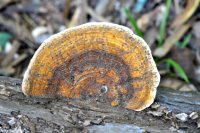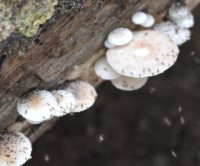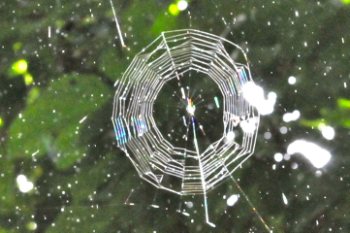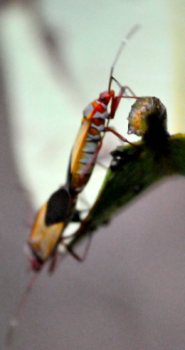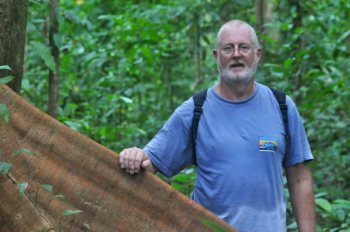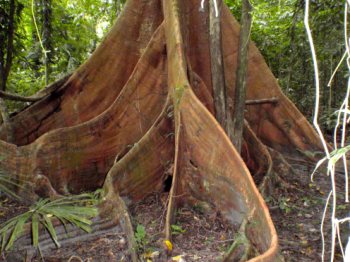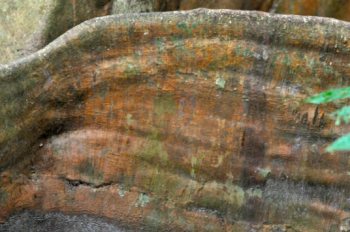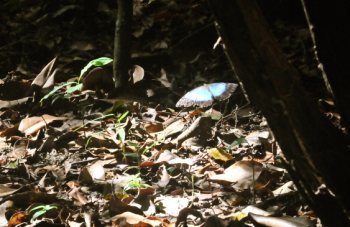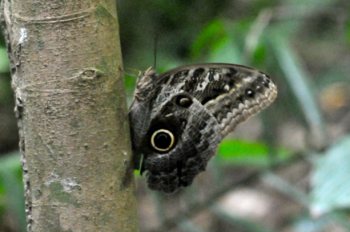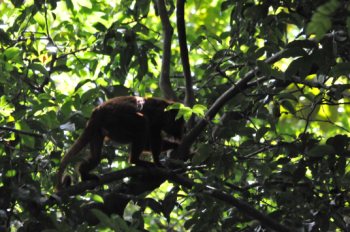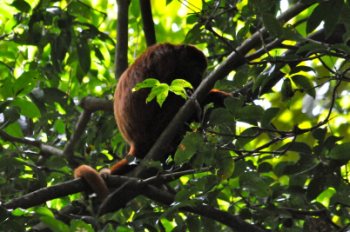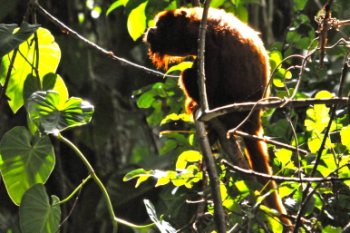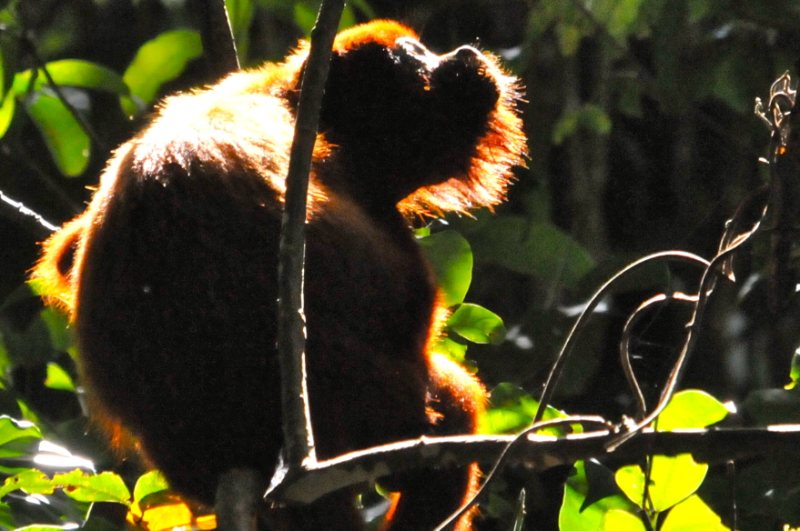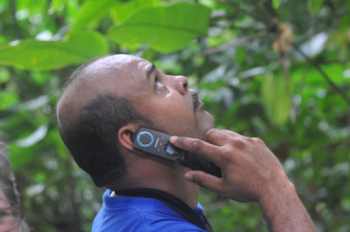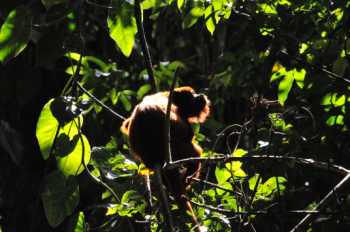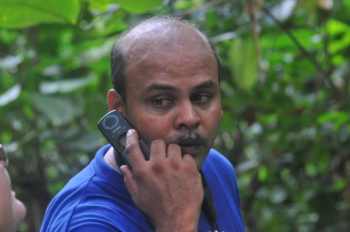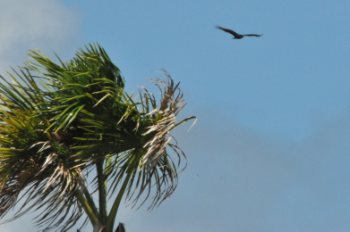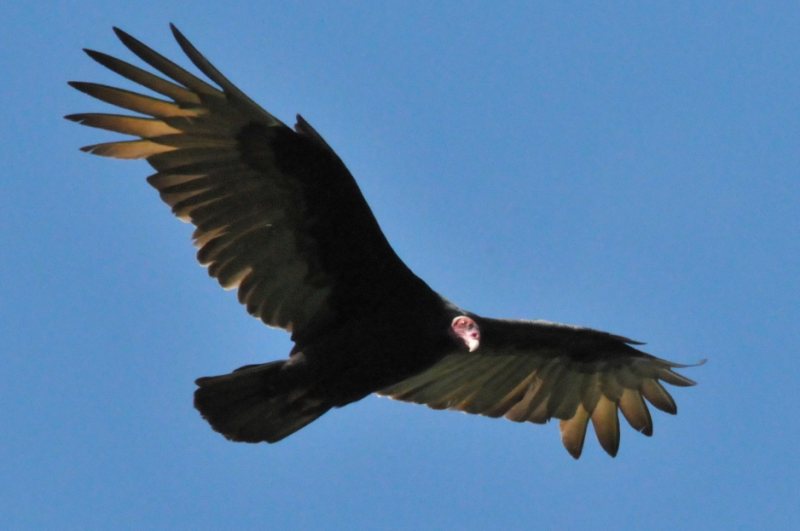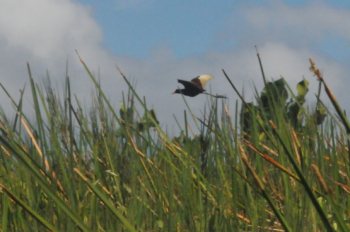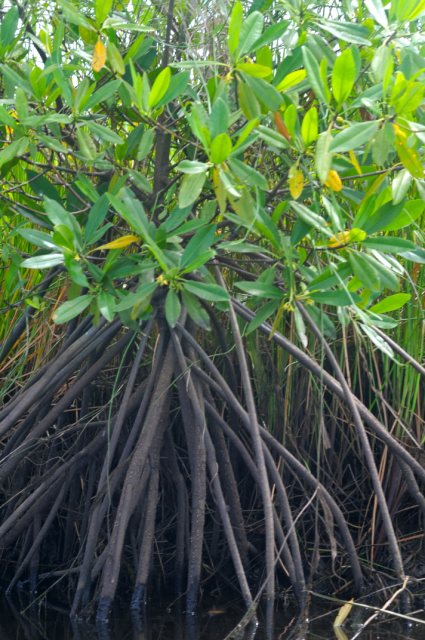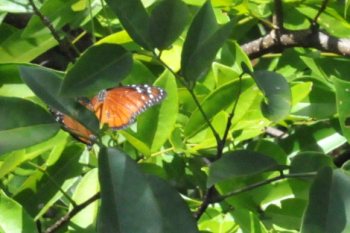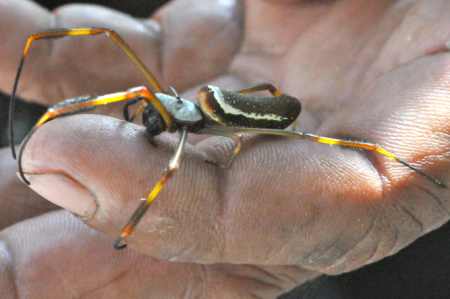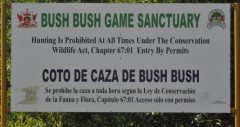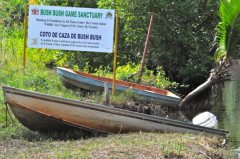|
The Nariva Swamp
Everyone off the bus for doubles.
Not sure what Jesse is saying here. As we pulled into
the car park at the swamp there was a "one careful
owner".
Jumped up at 05:00 to be ready for Jessie to pick us up at
05:30 to travel the hour and a half to the Nariva Swamp. En route, of course, we
stopped for doubles, I capitulated and said Bear could have ONE providing he
didn't ask for hot sauce. These were different in as much they had wonderful
crispy outsides whilst not having too many chickpeas inside. We also stopped for
Jessie to order our Roti lunch. Soon we saw the beach and a short while later we
enterred the car park for our tour with Short Man. Nariva Swamp (nuh-REE-vuh),
is on the East of Trinidad about thirty five miles South East of Port
of Spain, a low area stretching from palm-lined Cocos Bay on East coast nearly
five miles inland. A wetlands haven for migratory birds.
We boarded a boat with our guides and headed off. This access ditch was dug in 1963. We passed
savannah. New mangrove and Jesse on the look-out.
The Nariva Swamp is the largest freshwater wetland
in T+T and has been designated a
Wetland of International Importance under the Rasmar
Convention. The
swamp covers over twenty three square miles and the area provides
important habitat for waterfowl and is key habitat for the West Indian
Manatee, Caimans, Anacondas, Boa Constrictors, Red Howler
Monkeys, numerous species of parrots,
including both the Blue-and-Yellow and Scarlet Macaws. The difference between a parrot and a macaw
is facial feathers. The Macaw has skin on its face, which is unique like a
fingerprint. If I catch one knawing at my teak I'll be sure and get my John Bull
Pad out. First thing to bite me was a falling soldier ant. Next Terry picked a
mosquito off my well slathered face. So much for Jungle Formula mosquito lotion
as recommended by The Tropical Diseases Hospital in London. No match for this
lot. I somehow knew it was going to be a painful and itchy
day.
We got out of the boat, waded through the edge of the swamp and was
soon in thick forest. The
group saw a red Howler Monkey carrying her baby but it was too dark
to photograph. Tree
barnacles.
The Nariva Swamp, 6234 hectares, was declared to be
a Forest Reserve in 1954. The Bush Bush section of the Nariva Swamp (3,480
acres) is an area of high ground that was declared as a wildlife sanctuary in
1968, and a prohibited area in 1989 by Dr. Keith Rowley (legal notice no 78 by
then Minster of Agriculture, Land and Marine Resources). The site was thus
reserved as a local and international research centre, and in theory no hunting
or harvesting was allowed on the site. Bush Bush - the area we visited, is
historically important as a field site for the Trinidad Regional Virus Lab
(TRVL), (now CAREC, the Caribbean Epidemiology Centre), they conducted
research on arboviruses and the important study of tropical mosquito-borne diseases. The
Nariva Swamp is protected by 3 main pieces of legislation: the Forests Act,
Chapter 66: 01; the Conservation of Wildlife Act, Chapter 67: 01; the State
Lands Act, Chapter 57: 01. Offences taken to court are usually related to
wildlife poaching and tree felling. This was not been entirely successful and
encroachment by squatters was on going (Ramsar, 1996).

A virus field worker taken in
1959
The Nariva Swamp has been threatened in the past by illegal
squatting; the conversion of land to cannabis and rice farming, illegal grazing
of livestock in the game sanctuary, overfishing and illegal timber harvesting,
illegal hunting and excessive trapping of birds for the pet trade (Ramsar,
1996). Illegal activity was originally detected in the early 1980's and by
the mid 1990's they had done untold damage. The farmers had dug canals to drain
the wetland and set fires to forest and marsh in order to clear accumulated
organic matter for rice cultivation. Local farmers, too, have used fires in
their fields, and, because wind direction can change suddenly, the fires
have often gone out of control and jumped into the forest or swamp. Fires are
not a natural phenomenon here, so the damage is enormous. Agrochemicals were
heavily used by the illegal rice farmers, but the local farmers also use them.
Other problems include the use of illegal fish traps and poaching. Mammals such
as agouti (Dasyprocta leporina) are killed for
meat. Birds such as Orange-winged (Amazona
amazonica), Cuban parrots (A.
leucocephala) and the Red-bellied Macaw (Ara
manilata) are caught for the pet trade. Both poachers and fishers
set fire to the forest and the banks of streams, and again, they get out of
control. Four major wetland vegetation
types occur in the Nariva Swamp - mangrove swamp forest, palm forest, swamp wood and
freshwater marsh. The Nariva Swamp is threatened by rice cultivation in the northwest and
watermelon cultivation in the
southwest. It has also been affected by channelisation in the swamp and
deforestation of its watershed.
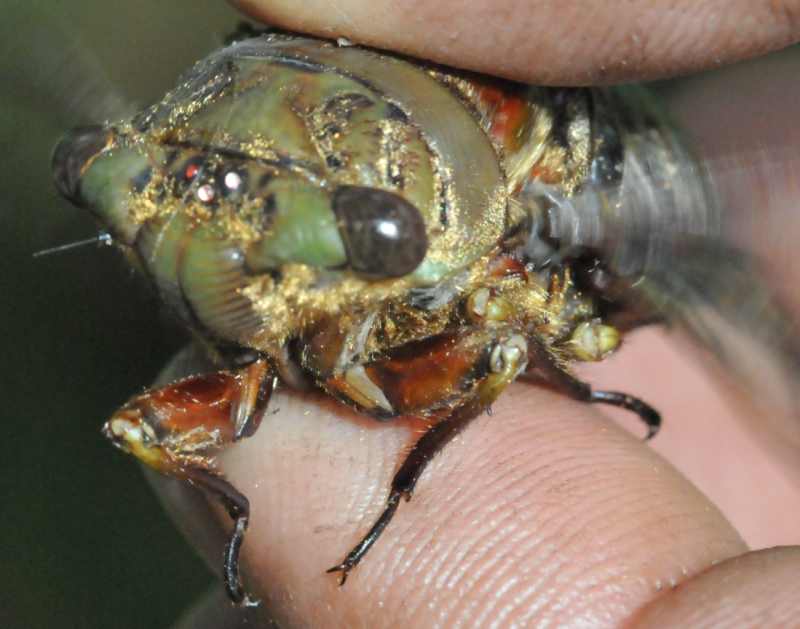
Sharwar our guide and boat driver caught me a Cicada to picture, the noise the wings made was awesome but
he was released unharmed
The Nariva Windbelt Forest Reserve of 6,267 acres (25.36
km2) was declared under the Forests Act on the 18th of March 1954.
This designation gives the Forestry Division the authority to manage the area
with reference to felling of trees, damage by negligence in felling any tree or
dragging any timber, fires and forest produce (CFCA, 1997). The year after the
establishment of the Nariva Windbelt Forest Reserve (1955) the Manzanilla
Extension, 383.2 hectares was declared a demarcated Forest Reserve.
Meet Short Man our lead guide,
always on the look out. Sharwar stayed with me
throughout the tour finding, holding and pointing out things for me to
photograph, he was a huge help and very patient.
Scientist T.H.G. Aitken proposed the Bush Bush wildlife
sanctuary in the Nariva Swamp as a nature reserve in 1960. In 1962, the
International Council for Bird Preservation raised a protest against proposed
logging operations by the Forestry Division in the Nariva Swamp; the Council
protested that it would reduce the high bird diversity in the area. At the
end of his study of parrots and macaws, scientists Dr. F. Nottebohm and Carl
Carlozzi recommended the complete legal protection of the Bush Bush and Bois
Neuf islands for the birds and other wildlife, the mud volcanoes on Bois Neuf
and the tourist potential they contained.
Interesting tree growth, aerial roots, hard fungus, Chinese Ginger and soft
fungus
The dots on this tree growth are
flying ants. Heliconia of course. The seed pod the Howler Monkeys love and a pretty fungus
Bonadie and Bacon (1998) confirmed that roosting sites for
orange-winged parrots (Amazona amazonica) and red-bellied macaws (Ara manilata
(Bodd.) were concentrated in Roystonea and Mauritia palm stands in
the Swamp and they only counted 136 parrots (a reduction from 600 in 1969)
and 224 macaws. The Conservation Ordinance allows orange-winged parrots to be
shot as crop pests, so that if the palm swamp forest is eliminated they will
become greater pests of cocoa and crops, and will face greater levels of irate
shooting. Parrots and macaws fed on seven plant species with the major
concentration of feeding on Mauritia setigera and Roystonea oleracea palm fruit.
The third psittacine species observed in the swamp were green-rumped parrotlets
(Forpus passerinus Lafr.).
Bear the Intrepid. A spiders web
high up in the canopy in the morning sun during a downpour, very little rain
actually got through to make us wet. A couple of
beetles "having a hug"
As a result of the public interest and a grant of $5000 U.S.
from the New York Zooloogical Society. In recognition of this interest, in
July 1968, the Trinidad and Tobago Tourist Board held a meeting with the
Forestry Division on the potential of the mouth of the Nariva River and its
eastern bank for tourism. Six years later in 1974, the Tourist Board offered
financial aid of $7000 to clear and maintain the Bush Bush canal to allow easier
access.
Bear next to an enormous Cottonwood Tree, beautiful rich
colours of one of the solid roots.
I managed to capture the elusive Blue
Morpho Butterfly in flight but got a better shot of it at rest. A
Daddy-long-legs.
Sharwar found us a really well camouflaged
Red Howler Monkey, he was so patient making calling noises until it paid
attention and posed for me. Eighty feet up at a distance of a hundred yards.
Even when you are 'spotting nature'
- you hear the ringtone "Mission Impossible" as Jesse
carries on working.
My next treat was to see a Turkey
Vulture soaring high above when we stopped at the Nariva Hilton, a wooden
shack.
Soon it was time to walk back to the tidal ditch and walk further in the waters edge as the
water level had lowered. We had seen Snowy Egret, a Great White Heron, Wattled
Jacana or Lily Trotter, a Pied Water Tyrant, Smooth Billed Annies and a Pigmy
Kingfisher. The trees we saw included the Silk Cotton, Canon Ball and the Maho.
We saw Red and Black Soldier Ants, Leafcutters and I got bitten by at least
seventy of the ninety two known species of Mosquito.
I found a relative of the Hoya
Bella, a sweetly scented plant we used to have in the conservatory, just
growing like a weed here.
It was quite nice that the boat engine packed up soon after
we got going, so instead of zooming along for twenty minutes we had a gentle
"punt". Short Man on the branch pull, Jesse using a machete as an oar and those
of us on the outer edge paddling with cupped hands, all very pleasant. We got to
see a Striated Heron. A baby mangrove tree and an Orange
Postmaster.
There was a lot of girlie squealing as the boat touched the
right bank and this chap got aboard for a hug. We knew him to be Harmless from
Guadeloupe.The last thing we saw was a shy Juvenile Common
Black Hawk - which is not common at all.
Time to leave the swamp and the "quiet engine", A total of
four monkeys and no White Howlers or Capuchin Monkeys was a little
disappointing, but that's nature for you.
ALL IN ALL THE FIRST TIME I HAVE PAID TO
BE TORTURED - BUT A FASCINATING DAY. A BIG THANK YOU TO
SHARWAR.
NOW OFF TO THE BEACH - YIPPEE
| 
